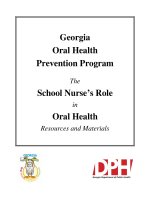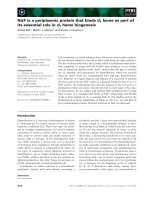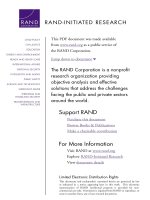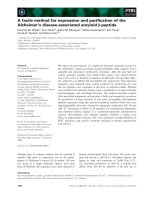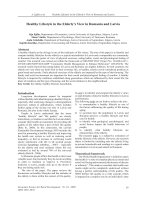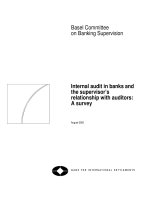Dental Caries Prevention: The Physician’s Role in Child Oral Health pdf
Bạn đang xem bản rút gọn của tài liệu. Xem và tải ngay bản đầy đủ của tài liệu tại đây (848.73 KB, 84 trang )
This report may be used, in whole or in part, as the basis for development of clinical practice
guidelines and other quality enhancement tools, or a basis for reimbursement and coverage policies.
AHRQ or U.S. Department of Health and Human Services endorsement of such derivative products
may not be stated or implied.
AHRQ is the lead Federal agency charged with supporting research designed to improve the quality of
health care, reduce its cost, address patient safety and medical errors, and broaden access to essential
services. AHRQ sponsors and conducts research that provides evidence-based information on health
care outcomes; quality; and cost, use, and access. The information helps health care decisionmakers—
patients and clinicians, health system leaders, and policymakers—make more informed decisions and
improve the quality of health care services.
Dental Caries Prevention:
The Physician’s Role in Child Oral Health
Systematic Evidence Review
Submitted to:
Agency for Healthcare Research and Quality
540 Gaither Road
Rockville, Maryland 20850
Submitted by:
RTI International
3040 Cornwallis Road
P.O. Box 12194
Research Triangle Park, North Carolina 27709
Contract No. 290-97-0011
Dental Caries Prevention:
The Physician’s Role in Child Oral Health
Systematic Evidence Review
Agency for Healthcare Research and Quality
Contract #290-97-0011, Task Order No. 3
Technical Support for the U.S. Preventive Services Task Force
James D. Bader, DDS, MPH*
Gary Rozier, DDS, MPH
†
Russell Harris, MD, MPH
‡
Kathleen N. Lohr, PhD
§
* UNC School of Dentistry and Sheps Center for Health Services Research, Chapel Hill, NC.
†
UNC School of Public Health, Chapel Hill, NC
‡
UNC Sheps Center for Health Services Research, Chapel Hill, NC
§
RTI International, Research Triangle Park, NC and UNC School of Public Health, Chapel Hill, NC
Preface
The Agency for Healthcare Research and Quality (AHRQ) sponsors the development of Systematic
Evidence Reviews (SERs) through its Evidence-based Practice Program. With guidance from the U.S.
Preventive Services Task Force
*
(USPSTF) and input from Federal partners and primary care specialty
societies, the Evidence-based Practice Center at Oregon Health Sciences University systematically
reviews the evidence of the effectiveness of a wide range of clinical preventive services, including
screening, counseling, and chemoprevention, in the primary care setting. The SERs—comprehensive
reviews of the scientific evidence on the effectiveness of particular clinical preventive services—serve as
the foundation for the recommendations of the USPSTF, which provide age- and risk-factor-specific
recommendations for the delivery of these services in the primary care setting. Details of the process of
identifying and evaluating relevant scientific evidence are described in the “Methods” section of each
SER.
The SERs document the evidence regarding the benefits, limitations, and cost-effectiveness of a broad range
of clinical preventive services and will help further awareness, delivery, and coverage of preventive care as an
integral part of quality primary health care.
AHRQ also disseminates the SERs on the AHRQ Web site ( />) and
disseminates summaries of the evidence (summaries of the SERs) and recommendations of the USPSTF in print
and on the Web. These are available through the AHRQ Web site and through the National Guideline
Clearinghouse ()
.
We welcome written comments on this SER. Comments may be sent to: Director, Center for Practice and
Technology Assessment, Agency for Healthcare Research and Quality, 540 Gaither Road, Suite 3000, Rockville,
MD 20850, or e-mail
Carolyn M. Clancy, M.D. Jean Slutsky, P. A., M.S.P.H.
Director Acting Director
Agency for Healthcare Research and Quality Center for Outcomes and Evidence
Agency for Healthcare Research and Quality
*
The USPSTF is an independent panel of experts in primary care and prevention first convened by the U.S. Public
Health Service in 1984. The USPSTF systematically reviews the evidence on the effectiveness of providing clinical
preventive services including screening, counseling, and chemoprevention in the primary care setting. AHRQ
convened the current USPSTF in November 1998 to update existing Task Force recommendations and to address
new topics.
The authors of this report are responsible for its content. Statements in the report should not be
construed as endorsement by the Agency for Healthcare Research and Quality or the U.S.
Department of Health and Human Services of a particular drug, device, test, treatment, or othe
r
clinical service.
Dental Disease Prevention: The Physician’s Role in Child Oral Health i
Contents
Chapter 1. Introduction………………………………………………………… 1
Epidemiology………………………………………………………………1
Prevention………………………………………………………………….4
Guidelines for Prevention of Dental Caries…………………………….5
Access…………………………………………………………………… 7
Analytic Framework and Key Questions……………………………….10
Chapter 2. Methods………………………………………………………………14
Studies Involving Primary Care Physicians………………………… 14
Studies in the Dental Literature………………………………………….15
Chapter 3. Results……………………………………………………………… 17
Accuracy of Screening by Primary Care Clinicians……………………17
Identifying Needed Referrals……………………………….……17
Effectiveness of Primary Care Clinician Referral
to a Dentist…………………………………………………… … 19
Effectiveness of Fluoride Supplementation…………………… 20
Effectiveness of Professional Fluoride Application…………….26
Effectiveness of Counseling for Caries Prevention…………….30
Chapter 4. Discussion…………………………………………………………… 33
Screening Accuracy……………………………………………………… 33
Referral Effectiveness…………………………………………………… 34
Effectiveness of Fluoride Supplementation…………………………… 34
Appropriateness of Supplementation Decision………………….34
Parental Adherence……………………………………………… 35
Effectiveness of Supplements…………………………………….35
Effectiveness of Fluoride Application…………………………………….38
Appropriateness of Application Decision……………………… 38
Effectiveness of Counseling………………………………………………40
Adherence to Recommendations and Caries Prevention…… 40
Other Issues: Pediatric Medications Containing Sugar……… 41
A Research Agenda……………………………………………….42
References…………………………………………………………………………45
Figure 1. Dental Care for Young Children from Primary Care Physicians:
Analytic Framework……………………… 54
Table 1. Search Results on Studies of Primary Care Providers’
Involvement in Child Oral Health…………………………………………… 55
Table 2 Sources of Data for Collateral Evidence
from the Dental Literature………………………………………………………56
Dental Disease Prevention: The Physician’s Role in Child Oral Health ii
Table 3. Studies Reporting Screening Accuracy
for Primary Care Providers……………………………………………………57
Table 4. Risk Indicators for Dental Caries in Children Suggested for Use
in Dental Practice…………………………………………… ……………….58
Table 5. Studies Reporting Referral Effectiveness………………………….59
Table 6. Physicians’ Knowledge of and Behavior Regarding Fluoride
Supplementation………………………………………………………………60
Table 7A. Effects of Fluoride Supplements on Primary Teeth:
Study Design Characteristics…………………………………………………61
Table 7B. Effects of Fluoride Supplements on Primary Teeth:
Study Results………………………………………………………………… 62
Table 8A. Clinical Studies of Fluoride Varnish Applied to Primary Teeth:
Study Design………………………………………………………………… 63
Table 8B. Clinical Studies of Fluoride Varnish Applied to Primary
Teeth: Results………………………………………………………………….65
Table 9. Summary of Systematic Reviews of the Effectiveness
of Oral Health Promotion and Education…………………………………….67
Appendix A. Acknowledgements………………………………………………A1
Appendix B……………………………………………………………………… B1
Dental Disease Prevention: The Physician’s Role in Child Oral Health 1
Chapter 1. Introduction
Issues of oral health in children revolve almost exclusively around dental caries. In the
United States, dental caries is the most common chronic childhood disease,
1
and its treatment is
the most prevalent unmet health need in children.
2
A substantial portion of caries lesions can be
prevented; indeed, the incidence of this disease has declined among school-age children and
adults in the past three decades. However, incidence among preschool children has not declined
at a similar rate over this same time period.
Epidemiology
Dental caries is an infectious disease that can occur when cariogenic bacteria colonize a
tooth surface in the presence of dietary carbohydrates, especially refined sugars. The bacteria
metabolize the carbohydrates, producing lactic acid, which over time demineralizes the tooth
structure.
3
The earliest visible manifestation of dental caries is the appearance of a
demineralized area on the tooth surface, which presents either as a small white spot on a smooth
surface or a pit or fissure. At this stage, a caries lesion is usually reversible. If oral conditions
do not change, demineralization will continue with the eventual result that the tooth surface loses
its natural contour and a “cavity” develops. At this stage, restorative treatment is necessary to
prevent the continuation of the caries process, which if left untreated will eventually result in
pulpitis and ultimately tooth loss.
Progression of individual caries lesions is typically slow, but it can be extremely rapid in
a small proportion of individuals and especially in primary teeth, which have thinner enamel.
Because dental caries is a chronic disease of microbial origin, modified by diet, the elimination
Dental Disease Prevention: The Physician’s Role in Child Oral Health 2
of active caries lesions through treatment does not necessarily mean that the disease has been
eradicated. An individual’s risk for dental caries can change with time as etiologic factors
change, leading to new caries events around already treated lesions or on previously unaffected
tooth surfaces.
Dental caries can occur soon after eruption of the primary teeth, starting at 6 months of
age. The most recent national survey (1988-1994) indicated that 52% of children 5 to 9 years of
age have experienced dental caries;
4
of children 2 to 5 years of age, 18.7% have at least 1
primary tooth with untreated decay.
5
Referred to as early childhood caries (ECC), dental caries
in preschool children can take several forms. The most severe form has a pattern of early initial
attack on the maxillary incisors with the attack continuing on other teeth as they erupt.
6
Dental caries incidence begins in the permanent teeth at about 6 years with the eruption
of central incisors and first molars. Among children 5 to 11 years of age, 26% have experienced
one or more lesions in permanent teeth; this proportion increases to 67% among adolescents 12
to 17 years of age.
7
Dental caries is unequally distributed among the population. Caries incidence,
prevalence, and severity is greater in minority and economically disadvantaged children.
2,4,5,8
Among children 1 to 2 years of age examined in the most recent national survey, all who had
obvious dental caries in the maxillary incisors were in the group with incomes at or below 200%
of the federal poverty line.
9
Among children 2 to 5 years of age, those in families at or below the
poverty level are 106% more likely to have experienced dental caries than children in families
with incomes above the poverty level.
5
At this same age, black children have 43% more
untreated carious primary teeth than white children, and children at or below the federal poverty
line have 138% more than children above the poverty line.
10
Dental Disease Prevention: The Physician’s Role in Child Oral Health 3
Dental caries in primary teeth can has both short- and longer-term negative
consequences. Caries lesions often cause pain because they can progress rapidly in primary teeth
and involve the pulp before they are either detected or treated. About 1 in 10 children 2 to 17
years of age and 1 in 5 children from low-income families made dental visits because they were
in pain or something was bothering them.
11
Regardless of their degree of progression, lesions
cavitated into dentin require reparative treatment or tooth extraction; both are frequently
traumatic experiences for young children. Young children with untreated, symptomatic carious
teeth often present to emergency departments of hospitals for their first dental visit.
12
Also,
untreated caries lesions in young children may be associated with failure to thrive,
13
although
evidence is conflicting regarding this association.
14
Social outcomes of dental caries in young
children are poorly documented, but children 5 to 7 years of age in the United States have been
estimated to lose more than 7 million school hours annually because of dental problems and/or
visits.
15
Untreated caries typically is cited as leading to increased infections, dysfunction, poor
appearance, and low self-esteem,
16
but most of these associations stem from conventional
wisdom rather than observational studies.
Longer-term consequences of dental caries in primary teeth include an increased
probability of caries in the permanent dentition
17,18
and possible loss of arch space. Lack of
treatment for caries in primary teeth will often result in the premature loss of the primary teeth,
especially molars, which are at risk for the longest period. Premature loss of primary molars can
lead to loss of arch space as the first permanent molars drift into the missing tooth spaces.
19
The
result can be crowding of the permanent teeth, the severity of which depends on the amount of
lost space. Anterior tooth crowding affects aesthetics and may necessitate orthodontic treatment
for correction.
Dental Disease Prevention: The Physician’s Role in Child Oral Health 4
Some dentists believe that crowding increases the risk of both caries and periodontal
disease in the permanent dentition because of the disruption of normal tooth-to-tooth relations
that promote self-cleaning. This widely held belief is not well supported by observational
studies, however.
Prevention
Approaches to the prevention of dental caries involve attempts to reduce the
microbiological burden, reduce the availability of refined sugars, increase the resistance of teeth,
or some combination of these approaches. Reducing the microbiological burden is the focus of
interventions using antimicrobial rinses and dentifrices and behavioral interventions to improve
oral hygiene and thus remove the bacterial plaque coating tooth surfaces. Behavioral
interventions are also used to reduce the availability of fermentable carbohydrates through
changes in the composition of the diet and frequency of ingestion of refined sugar. Increasing
the resistance of teeth is typically achieved through the use of sealants and fluorides. Sealants
are applied to the occlusal surfaces of molars and premolars, denying bacteria access to these
often hard-to-clean areas. Fluorides are used both topically (fluoride dentifrices, rinses, gels,
foams, and varnishes) and systemically (fluoridated water, dietary fluoride supplements) for both
prevention and management (i.e., remineralization) of dental caries. After exposure, fluoride
becomes available in plaque, saliva, and the tooth’s outer layer, where it increases resistance to
acid dissolution, serves as a reservoir for remineralization of the initial caries lesions, or acts as a
bacterial inhibitor when released through acid dissolution.
3,20
Another approach currently
receiving attention but not yet widely endorsed attempts to eliminate transmission of cariogenic
Dental Disease Prevention: The Physician’s Role in Child Oral Health 5
bacteria from caregiver to child through the use of antimicrobial and behavioral interventions to
reduce the reservoir of bacteria in the caregiver.
21,22
Guidelines for Prevention of Dental Caries
A growing number of guidelines provide recommendations on individual, professional,
and community interventions to prevent and control dental caries.
4,23-30
Most recently, the Task
Force on Community Preventive Services has supported the effectiveness and safety of
community water fluoridation; like several of the more recent guidelines, this statement is based
on systematic reviews of the evidence of effectiveness and safety.
31
In 1996, the U.S. Preventive Services Task Force (USPSTF) recommended (in Chapter
61 of the Guide to Clinical Preventive Services) counseling patients to visit a dental care
provider on a regular basis, floss daily, and brush their teeth daily with fluoride-containing
toothpaste based on evidence of risk reduction from these interventions.
32
The USPSTF also
recommended counseling caregivers to avoid putting infants and children to bed with a bottle.
Dietary fluoride supplementation (hereafter referred to as fluoride supplementation) of persons 6
months to 16 years of age who drink water with inadequate fluoride was recommended based on
well-designed controlled trials.
The 1995 Canadian Task Force on Preventive Health Care (CTFPHC) focused on dental
interventions per se; they recommended water fluoridation, fluoride supplementation in low-
fluoride areas, professional topical fluoride, and self-administered fluoride mouth rinses for
persons with active decay or specific risk factors, and use of fluoride dentifrice.
24
An expert panel convened by the Centers for Disease Control and Prevention (CDC)
recently conducted a critical analysis of scientific evidence regarding the efficacy and
Dental Disease Prevention: The Physician’s Role in Child Oral Health 6
effectiveness of fluoride modalities in the prevention and control of dental caries.
27
Fluoride
toothpaste, mouth-rinse, gel, and varnish were recommended based on the quality of the
evidence of effectiveness. For the first time, the evidence of effectiveness for fluoride
supplements was graded according to age. Prenatal supplements were not recommended based
on the results of a single randomized controlled trial. Supplements were recommended for
children and adults, but only for those at high risk for dental caries. The evidence for caries
prevention was judged to be good for school-aged children and poor for preschool-aged children
and adults; but targeting high-risk patients was based on expert opinion alone.
The American Academy of Pediatrics (AAP) has endorsed the CDC fluoride guidelines,
thus supporting (a) community water fluoridation and fluoride toothpaste for use by the general
population and (b) targeted use of professional fluoride products, including prescription of
dietary fluoride supplements.
30
The American Dental Association (ADA) in one of its widely
distributed publications also recommended limiting the use of dietary fluoride supplements and
other professional fluoride products to patients with moderate to high caries risk (i.e., having 1 or
more risk indicators for dental caries).
23
Guidelines on fluoride therapy published by the
American Academy of Pediatric Dentistry (AAPD) are not specific on use of fluoride according
to caries risk.
25
Other than the CDC fluoride guidelines for dietary fluoride supplements and
fluoridated toothpaste, none of these guides is specific to young children. Appendix B provides
a comparison of guidelines for supplements (Appendix Table B1) and professional application of
fluorides (Appendix Table B2).
Dental Disease Prevention: The Physician’s Role in Child Oral Health 7
Access
Several dental organizations, including the AAPD and the ADA, recommend a first
dental visit when a child is about 1 year of age.
33
Bright Futures recommends a dental
appointment beginning at 12 months of age also, a stance that is endorsed by more than two
dozen health organizations.
34
Available information suggests that the majority of children see a
dentist for the first time rather later in life, but national data on age at first dental visit are not
available. Data from the Medical Expenditures Panel Survey and the National Health and
Nutrition Examination Survey describe proportions of the child population 2 to 5 years of age
who had a visit in the past year; estimates vary from 20%
35
to 30%,
36,37
suggesting that the mean
age at first visit is more likely between 3 and 5 years. More recent data will be necessary to
determine if the public and dental professions are following the newer guidelines on age at first
dental visit.
Access to dental care for young children enrolled in Medicaid is a particularly severe
problem. Of children 1 to 5 years of age enrolled in the Early and Periodic Screening,
Diagnostic and Treatment (EPSDT) Program, 16% receive any preventive dental care even
though all are eligible for these benefits.
4
A large percentage of young children with early
childhood caries are able to get only emergency dental services, at best. A study of North
Carolina’s Medicaid population found that as few as 2% of 3-year-old enrolled children received
comprehensive care in a 12-month period.
38
Reasons for the poor access that young children have to dental services are numerous and
complex. Two situations in particular contribute to the access problem. First, general dentists
are reluctant to treat young children; only a limited number of dentists have specialty training in
their care. About 3,600 pediatric dentists nationwide supply 1 pediatric dentist for every 6,000
Dental Disease Prevention: The Physician’s Role in Child Oral Health 8
children younger than 6 years of age.
11
Second, in most states, Medicaid reimburses dentists
only a fraction of their usual, reasonable, and customary charges, making the treatment of any
Medicaid patients financially unattractive.
Compounding the problems of access to care for Medicaid and uninsured children is that
the dental safety net does not function well in most areas of the country. Local, state, and federal
dental programs have limited resources to meet the dental needs of those populations with
limited access to private dental care.
4
For example, 4 major federal programs target underserved
populations: the Health Center program that funds community and migrant health centers, the
Indian Health Service dental program, and the National Health Service Corps and Indian Health
Service loan repayment programs, both of which provide incentives for dental providers to
practice in medically underserved areas. The General Accounting Office assessed all of these
programs as having only a limited effect on improving access to dental services for their targeted
populations.
36
Use of ambulatory health care in the medical office setting during the first year of life and
from 1 to 4 years is 78% and 84.1%, respectively.
39
Use of dental care is 0% and 19.2%,
respectively, for these same 2 age groups, demonstrating the large difference in utilization of
medical care and dental care by young children. Problems with access to dental care underscore
the role that primary care physicians and other child health care providers can play in providing
access to preventive dental services, particularly for very young children and those who do not
have access to dental care. Among young children who have experienced dental caries, a
professional preventive intervention for dental caries presumably would have reduced or
eliminated the incidence of disease. Yet, many children do not make a dental visit until well
Dental Disease Prevention: The Physician’s Role in Child Oral Health 9
after the disease has progressed beyond the reversible stage. Also, those least likely to make an
early dental visit are those most likely to have dental caries.
Physicians and other primary care clinicians (PCCs) see child patients during this at-risk
age before the first dental visit, providing an opportunity for them to take preventive action.
Recommendations for physician interventions addressing dental caries include oral health
screening and referral when indicated, provision of oral hygiene, dietary information, and
anticipatory guidance to parents, and prescription of fluoride supplements.
30,34
PCCs also now
apply fluoride varnish.
The USPSTF has limited its consideration of dental health to issues associated with
prevention of dental caries in preschool children. Although the complete scope of prevention of
dental diseases is much wider, the rationale for focusing on preschool children and dental caries
is compelling. As noted, physicians have a role in providing dental preventive services to young
children. Physicians are much more likely to see preschool children than are dentists, a situation
that does not reoccur until late in life. The caries process can start at an age when most children
have not visited a dentist, reducing the potential for preventive interventions by dentists and
permitting extensive destruction before dental intervention. Well-defined preventive procedures
within the scope of medical practice are available for physicians to utilize in this preschool
population.
Thus, a sound theoretical basis exists for a focus on the role of physicians in the
prevention of dental caries in preschool children. This review is not intended to suggest that the
role of the physician should supplant the role of the dentist in maintaining the oral health of
preschool children. Rather, the fundamental assumption of the review is that the responsibility
for management of a child’s oral health is shared among PCCs and dentists, and major
Dental Disease Prevention: The Physician’s Role in Child Oral Health 10
responsibility is transferred from a PCC to a dentist at a point in time arranged jointly by the
PCC, parents, and dentist.
This report represents a departure from the chapter on Oral Health that appeared in the
1996 edition of the Guide to Clinical and Preventive Services. That chapter focused on
counseling for the prevention of dental diseases in all ages. This summary of evidence focuses
exclusively on the evidence of effectiveness for procedures applied by physicians and other
primary care clinicians to prevent carious lesions in young children .
Because of these different emphases, many of the recommendations from the 1996 Guide
to Clinical and Preventive Services are not reexamined in this report.
Analytic Framework and Key Questions
The analytic framework for this review (Figure 1) represents a risk-based approach to the
prevention and management of dental caries. It begins with a child’s visit to a PCC, presumably
a well-child visit. The PCC screens the child for both the presence of dental caries and risk
indicators for dental caries. Depending on the results of the screening (either identification of
suspected caries lesions or recognition of elevated risk for dental caries), the physician either
refers the child to a dentist or initiates one or more preventive interventions (prescription of
supplemental fluorides, application of fluoride varnish in the office, counseling the parents
concerning caries preventive behaviors). The counseling intervention may include referral as
well. If no disease or risk factors are identified, the PCC may also undertake counseling. This
arm as well as the outcomes of treatment by dental professionals, are shown by dotted lines,
indicating that we did not evaluate them in this review.
Dental Disease Prevention: The Physician’s Role in Child Oral Health 11
The framework is intended to outline general types of interventions that PCCs provide
and that are appropriate to children between birth and 5 years of age. Although prenatal
counseling is recommended by some professional health care organizations and may be
appropriate, it is not a focus of this review. Similarly, application of dental sealants, another
effective dental care preventive service, is outside the scope of the review because it is unlikely
to be feasible for PCCs to provide this service.
We developed 5 key questions to direct the review.
1. How accurate is PCC screening in identifying children ages 0 to 5 years who:
(a) have dental caries requiring referral to a dentist?
(b) are at elevated risk of future dental caries?
2. How effective is PCC referral of children ages 0 to 5 years to dentists in terms of the
proportion of referred children making a dental visit?
3. How effective is PCC prescription of supplemental fluoride in terms of:
(a) appropriateness of supplementation decision?
(b) parental adherence to the dosage regimen?
(c) prevention of dental caries?
4. How effective is PCC application of fluoride in terms of:
(a) appropriateness of application decision?
(b) achieving parental agreement for the application?
(c) prevention of dental caries?
5. How effective is PCC counseling for caries-preventive behaviors as measured by:
(a) adherence to the desired behavior?
(b) prevention of dental caries?
Dental Disease Prevention: The Physician’s Role in Child Oral Health 12
For Key Question No. 5, the caries-preventive behaviors of interest relate to diet
(reduction in frequency and amount of sucrose, appropriate use of the bottle), oral hygiene
(brushing frequency and efficacy), dental attendance (regular dental examinations and first visits
for assessment of risk of disease), appropriate use of fluoride (accepting professional
recommendations, use of fluoride dentifrice at home), and implications of caregiver oral health
(possible transmission of cariogenic bacteria).
Dental Disease Prevention: The Physician’s Role in Child Oral Health 14
Chapter 2. Methods
For each of the 5 key questions, we first searched the literature for studies that involved
primary care practitioners. Because we anticipated finding only a limited number of studies
addressing the performance of PCCs in these essentially dental roles, we also planned from the
outset to address Key Questions 3, 4 and 5 using the dental literature. Our approach here was to
base the appraisal of the evidence on existing systematic and traditional reviews of the literature
whenever possible.
Studies Involving Primary Care Clinicians
We used separate searches for 3 of the 5 key questions; we combined the 2 fluoride-
related questions (Key Questions 3 and 4) into a single search. We searched the English
language literature in MEDLINE from 1966 to October 2001. Appendix Tables B3-B6 detail the
search terms and numbers of articles produced for each term for each of these searches. We used
combinations of (a) terms defining primary care providers or primary care sites and (b) terms
defining the dental topics embodied by the individual questions.
Our initial searches included terms capturing a wide range of research designs, from
randomized controlled trials (RCTs) through questionnaire surveys. We then added any studies
we identified in the Cochrane Controlled Trials Register and those identified through review of
the references in papers found by the searches and through personal knowledge.
For each of the resulting 4 sets of papers, 2 reviewers independently reviewed each
abstract to identify those studies eligible for full review. Criteria for this level of review were
simply that the study addressed the key question, reported original data, and involved primary
Dental Disease Prevention: The Physician’s Role in Child Oral Health 15
care practitioners. Papers undergoing full review for inclusion were subjected to the same set of
criteria. When we identified studies, we prepared abbreviated evidence tables summarizing their
content.
Studies in the Dental Literature
Because of the small number of studies identified that involved PCCs, we pursued our
planned strategy of using a combination of existing reviews and new searches in the dental
literature to provide necessarily collateral evidence of effectiveness for 3 questions:
supplemental fluoride, applied fluoride, and counseling for caries preventive behaviors. We
identified recent systematic reviews that addressed the effectiveness of applied fluoride and
counseling.
We could not identify an appropriate review for the effectiveness of prescribed
supplemental fluoride for caries reduction in primary teeth, regardless of who made the
prescription. Although reviews on the topic were numerous, none included the collection of
studies that we thought pertinent to the key question. Therefore, we performed a modified
systematic review for this question wherein we identified all possible studies by searching and
examining reviews of the topic and then searching forward from the most recent review
(Appendix Table B7). We included controlled prospective studies in English in which the
intervention began before 5 years of age and investigators assessed outcomes for primary teeth
and/or permanent teeth. We accepted the absence of baseline prevalence data when initiation of
supplementation occurred before eruption of the primary teeth. The controlled, prospective
study criterion excluded more than half of the English language studies traditionally cited in
support of the effects of supplementation in primary teeth, which employed retrospective or
Dental Disease Prevention: The Physician’s Role in Child Oral Health 16
cross-sectional designs with no assignment or baseline examination (Appendix Table B8). We
used a separate recent systematic review of fluorosis associated with the dietary intake of
fluorides to assess the harms associated with supplements, as most of the included studies did not
address this outcome.
40
Dental Disease Prevention: The Physician’s Role in Child Oral Health 17
Chapter 3. Results
Table 1 summarizes the results of the searches for studies involving PCCs. It shows (a)
the number of studies initially identified by the search, (b) the number of additional studies
identified through other sources, (c) the number of these studies that either of 2 reviewers
targeted for detailed review, and (d) the number found to address the key question irrespective of
the research design employed by the study. Table 2 summarizes the sources of collateral
evidence for effectiveness from the dental literature for 3 key questions.
Accuracy of Screening by Primary Care Clinicians
Identifying Needed Referrals
We considered screening to consist of visual oral examination and parental interview.
We searched only for reports involving accuracy of the visual examination in identifying
treatment needs requiring referral to a dentist.
We found 2 studies germane to the visual oral examination component of PCC screening
accuracy among children; both reported the performance of a single PCC visual screener, a nurse
and a pediatrician (Table 3).
41,42
The pediatrician identified presence or absence of “nursing
caries,” i.e., a caries lesion on any teeth other than mandibular incisors through examination with
a mirror among children 18 to 36 months of age. No criteria for visual recognition of caries were
reported, and 4 hours of training were provided. The comparison standard was a similar
screening by a pediatric dentist. The nurse identified presence or absence of caries lesions,
restorations, fluorosis, intraoral injuries, sealants, and urgent and nonurgent treatment needs
Dental Disease Prevention: The Physician’s Role in Child Oral Health 18
among children 5 to 12 years of age using a flashlight and tongue blade. Caries lesions were to
be noted only if cavitation (loss of surface continuity) was present. Five hours of training
preceded the assessment. The comparison standard was a visual-tactile screening examination
by a dentist.
In both studies, the clinicians achieved high levels of screening accuracy (sensitivity and
specificity) for dental caries following training. Sensitivities were 100% and 92% and
specificities were 87% and 99% for the pediatrician (20% prevalence) and nurse (35%
prevalence), respectively.
41,42
The nurse performed similarly in identifying children with
restorations but was less accurate in identifying fluorosis, injuries, sealants, and nonurgent
treatment. Many of the children in this study were older than 5 years, which may have reduced
behavioral problems, thereby improving examination conditions.
Identifying Elevated Risk for Caries
Although formal risk categorization is infrequent in current dental practice, its use has
been encouraged.
43,44
The number of risk indicators for dental caries is large,
18,28
and subsets of
these indicators are frequently suggested for use in dental practice. Table 4 lists risk indicators
identified in 2 widely distributed sources, the Bright Futures project from the Health Resources
and Services Administration (HRSA)
34
and the Journal of the American Dental Association’s
special supplement on caries diagnosis and risk assessment.
23
The clinical risk indicators most accessible for PCC to use in screening preschool
children are the presence of caries lesions, plaque retention, and the presence of white spots or
other evidence of demineralization, such as discolored pits and fissures of teeth. PCCs might
ascertain several of the socio-environmental and behavior indicators by interview or
questionnaire, and they may already be available through health history and behavioral data that
Dental Disease Prevention: The Physician’s Role in Child Oral Health 19
are routinely collected. Nevertheless, we found no studies that examined PCC accuracy in
identifying children who displayed one or more risk indicators using these or other risk
indicators, with the exception of the studies summarized under key question 3a, which examine
the appropriateness of PCC’s decisions regarding fluoride supplements.
Effectiveness of Primary Care Clinician Referral to a Dentist
A single case study reported on the effectiveness of PCC referral (Key Question No. 2).
45
The study (Table 5) examined the effectiveness of referrals to dentists made by health
professional assistants for the Women, Infants and Children (WIC) Supplemental Food Program
for eligible children ages 6 months to 5 years. Children who were referred on the basis of non-
normal findings during intraoral screening examinations were almost twice as likely to have
made a dental visit in their lifetime than children who were not referred, 37% compared to 19%.
The study did not control for time elapsed since the referral had been made, and the difference in
the visit rates was not significant when controlled in a multivariate analysis for child age,
maternal age, household size, presence of dental insurance, and mother’s perception of the
child’s dental needs. We did not examine collateral evidence in the dental literature for this
question because no parallel situation exists.
A study that did not meet the inclusion requirement of patient contact in an office or
clinic environment reported still less effective results.
46
When health visitors in England referred
children ages birth to 2 years to dentists for dental examinations, 21% of those referred actually
visited a dentist.


